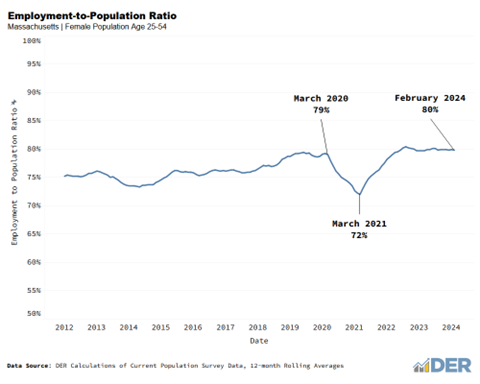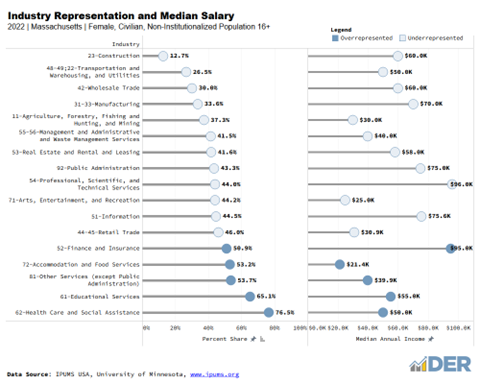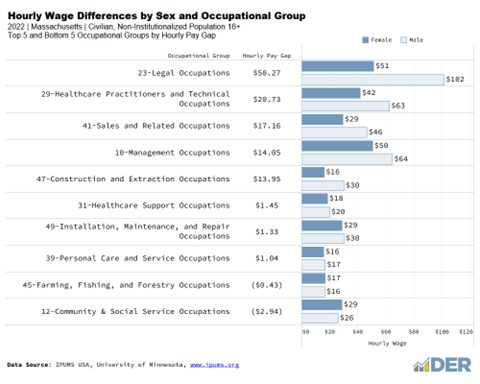- Executive Office of Labor and Workforce Development

This Women’s History Month, we celebrate women across Massachusetts and their contributions to our workforce and economy. Their resilience, determination, and innovative spirit have not only transformed industries but also inspired change on a societal level, making Women's History Month a time not just for celebration but also for reflection on the progress we've made and the work that still lies ahead.
Analyzing data from the U.S. Census Bureau’s Current Population Survey and Integrated Public Use Microdata Samples, the Department of Economic Research conducted an analysis of labor market data on female-identifying workers in Massachusetts. Sex is self-reported by participants in these surveys.
Female, Prime Working-Age Employment Back to Pre-Pandemic Levels
Before the COVID-19 Pandemic, the prime working-age (25-54) female employment-to-population ratio in Massachusetts grew steadily, reaching a high of 79% in early 2020 before dropping to 72% in 2021. However, post-pandemic recovery was swift, and employment-to-population ratios have since exceeded the 79% pre-pandemic high and stabilized at this level throughout early 2024.
Females Underrepresented in Some Industries, Overrepresented in Others
Although 49.8% of the working-age population in Massachusetts is female, only 12.7% of workers in the construction industry are female. Other examples of industries where females are underrepresented include transportation, warehousing, and utilities (26.5% share) and manufacturing (33.6%) where the median annual income ranges from $50,000 to $70,000.
By contrast, females are overrepresented in industries such as educational services (65.1%) and healthcare and social assistance (76.5%) where the median annual income generally falls in the $50,000 range.
Female Workers Typically Earn Less Per Hour Than Their Male Counterparts
In legal occupations, men were found to earn $50.27 more per hour than women. Similarly significant pay gaps were seen in healthcare ($20.73) and sales positions ($17.16).
One source of the difference in earnings is the differences in pay across jobs within each occupation group. For example, in legal occupations, lawyers, paralegals, and legal support workers have drastically different pay scales. Despite the fair representation of female lawyers (46.2%), which closely aligns with the female share of those employed (49.8%), females are significantly overrepresented in lower-paying legal roles, such as paralegals and legal assistants (87.2%), where the average hourly wage is below $30.
However, even accounting for differences in roles, substantial discrepancies in pay persist within the same occupation across genders. For example, male physicians average $88 per hour, while female physicians average $74 per hour. Further research needs to be done to understand the factors (specialization, experience, etc) contributing to the pay disparities within the same occupation.
Healey-Driscoll Administration Efforts to Uplift the Female Workforce
Earlier this month, the Healey-Driscoll Administration unveiled its workforce agenda, outlining the administration’s vision, goals, and strategies to support workforce development statewide is part of the Workforce Innovation Opportunity Act (WIOA) State Plan, required for submission every four years to the federal Department of Labor (USDOL) and federal Department of Education (USDOE) by Massachusetts.
As Massachusetts invests in talent pipelines and career pathways for residents, including female workers, it is imperative that workforce strategies align with industry hiring demands expressed by employers today, and projected by employers for future in-demand occupations across the state. With the goal of strengthening Massachusetts’ talent pipelines, a collaborative workforce system needs to prepare future talent and create upskilling pathways for workers through effective education and training models that will fuel priority industries and occupation.
You can learn more about Massachusetts’ Workforce Agenda here.
This blog is a collaboration between the Executive Office of Labor and Workforce Development Communications team and the Department of Economic Research. For more labor market information, including interactive dashboards, data visualizations, and more, visit www.mass.gov/EconomicResearch.



